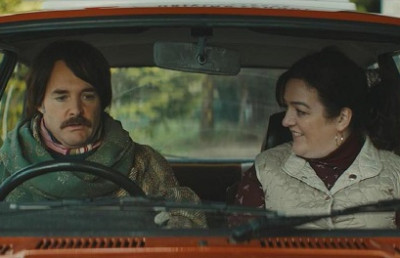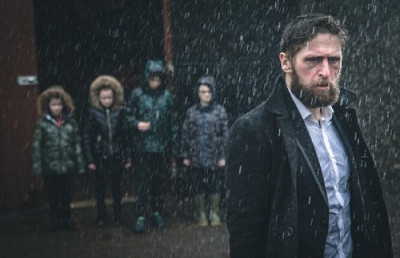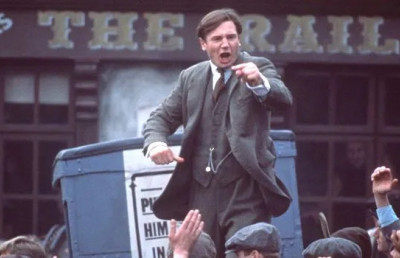The 27th Tallinn Black Nights Film Festival (PӦFF)
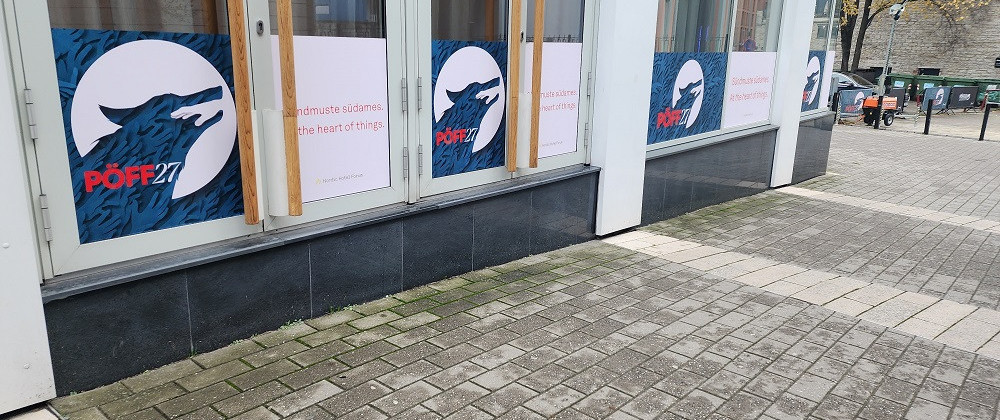
Tallinn Black Nights Film Festival (with wolf mascot) (photo source, Joshua Polanski)
The only International Federation of Film Producers Associations (FIAPF) A-list film festival in Northern Europe or the Baltic, Estonia’s Tallinn Black Nights Film Festival just wrapped up its 27th year and celebrated by breaking all major attendance records from the festival’s history, as PӦFF director Tiina Lokk-Tramberg shared at the closing ceremony. The programming integrally elevated the consistently underappreciated Eastern European cinema scene, specifically Baltic and Balkan cinema. An emblem of this was the festival’s opening selection, the Serbian Oppenheimer titled Guardians of the Formula, and in the inclusion of three programs for these regions: the Baltic Film Competition, Focus: Serbia and South East European Neighbours, and a retrospective on the Yugoslavian Black Wave.
From 3-19 November 2023, PӦFF27 screened 185 feature films from 73 countries (with an additional 51 feature films presented alongside the main programming through the Youth and Children sub-festival Just Film). The programming included 51 world premieres and 24 international premieres, most of which were shown in the heart of the capital of the Baltic region’s northernmost country. The festival had a decidedly non-Hollywood flare to it, which contributes to its annual neglect at the pens of major North American film publications. (I was one of only two critics who traveled from the United States for the festival, which shares the same accreditation as Berlin, Cannes, and Venice. I don’t believe any Canadians made the trip[1] .) But it’s also what makes it interesting.
I was most struck by the degree to which Black Nights felt like a national event. The President of the Republic of Estonia, Alar Karis, gave a speech and presented an award at the closing ceremony, a gesture of support that makes me wonder what it would be like for Joe Biden to attend Sundance or Justin Trudeau to put the full weight of the Canadian government behind TIFF. Would such political support, even at the gestural level, push a change in the pitiful Marvelized palette of the North American audience? The local Tallinn audience, which did the heavy lifting in breaking the attendance records, showed up in droves for obscure titles late at night. A few of my planned public screenings filled before I purchased my tickets, a process I began just a few hours after they announced the full competition program. I met a few cinéastes who traveled from countries near and far to attend the festival for their fifth, tenth, or even twentieth time (one woman living in Germany, whom I shared a ride to the airport with, had been around since the first festival!)

Chinese director Xie Fei on PӦFF stage (photo source, Joshua Polanski)
Inside the city with a population of about 426,000, the three theaters most utilized were within a 15-minute walk from each other—something simply flabbergasting for someone raised in the Midwest of the United States. The majority of the screens at the Apollo Kino Coca-Cola Plaza looked perpetually reserved for the festival titles, limiting the possible showings for the new Marvel movie. But that didn’t seem to hurt theater attendance at all because Tallinn, I have learned, is a city of cinephiles.
Contained within the few hundred features screened at PӦFF, several of the year’s best and most original films premiered or continued their journey on the festival circuit, including the world premiere of an Argentinian film about voyeurism and polyamory titled Vera and the Pleasure of Others; an Estonian documentary about a restorative sauna culture that will compete in two categories at this year’s Academy Awards, Smoke Sauna Sisterhood; and a five-part vignette film that takes place entirely from within an Airbnb in Lithuania, aptly titled Five and a Half Love Stories in an Apartment in Vilnius, Lithuania.
Thanks in part to the Rebels with a Cause program that Five and a Half won, even the most frequent of festival goers would be hard-pressed to point to another A-list festival with a more formally innovative selection of titles. Both Twittering Soul 3D, a Lithuanian film entirely conceived of in 3-D, and The Waves, The Sand, and Two Lovers in the Middle Of…, a grainy queer romance from South Korea, stylistically dare to think of images as containing potential beyond verisimilitude. The Polish Academy Award submission The Peasants, which lost to Smoke Sauna Sisterhood in the Best Baltic Film program (co-produced by Lithuania), may be the best film of the year. Every frame of the film, which took 200,000 hours of painting to finish, swims with movement and detail in a way that no film ever has before, not even the previous film by directors DK Welchman and Hugh Welchman, Loving Vincent. In an exciting new chapter for animation, artistry replaces craftsmanship.
In total, I viewed 33 feature films in Tallinn and caught a few additional titles preceding my trip over the course of the past few months for my multi-outlet coverage. The best films challenged visual and formal conventions in a way that’s informed not in contrast to the mainstream, as do the rising North American innovators, but in near complete disregard of the established standards of mainstream corporate filmmaking of Hollywood. The following five films, reflecting this artistic value Black Nights appears to hold itself to, provoked something in me that made them worth writing about.
Twittering Soul 3D
The first Lithuanian film to use stereoscopic illusion, Twittering Soul might be one of the weirdest films ever conceived in 3-D. It also uses a rare dialect of Lithuanian mixed with old Polish, a series of abstract images, and an infinite supply of folk songs from the region that do more to color a mood than assuage any sort of easily discernible plot.
I’m daunted even to begin a cursory summary of this abstract mythical film, so it will have to suffice to say this: two traveling musicians try to figure out what life after death looks like, a rich landowner obsesses over stereoscopic images, and well-intended witches are part of everyday life in the old Lithuanian countryside. Director Deimantas Narkevičius, a very well-known multi-modal artist from his country, is right to describe the film as a “psychedelic fairytale.” If the magical-realist descriptor didn’t belong to the Latin American literature movement of the 1960s, it would perfectly describe the appeal of Narkevičius’s film.
Twittering Soul, which competed in the Baltic section, continues a tradition of casually creepy liminal-folkloric in Baltic filmmaking. (Perhaps it would be fine to generalize this to Northern Europe, seeing as the Nordic countries also regularly produce films of this sort as well.) After all, Andrei Tarkovsky filmed Stalker in Tallinn. Uģis Olte’s 2021 film Upurga, set on the Latvian-Estonian border and involving mundane magic from the indigenous Livonians feels of a piece with Narkevičius’s feature, albeit as a bit more genre-conforming sibling. The Estonian November (2017) also sits comfortably in between the real world and the magic one. In the case of Narkevičius’s film, the old-fashioned tripod set-up of the stereoscopic cameras limits movement and the possibility of close-ups, adding something of an early silent-era feel to the production that complements the liminality.
Cinematographer Eitvydas Doškus, through stereoscopy, uses deep focus throughout the picture to give each image compositional depth. The interior scenes, with the production of South Lithuania in the 1890s, remind me of Vermeer and his layered compositions—a painter always near to Narkevičius’s creative impulses as I learned in my conversation with him. Often, a gaping streak of negative space marks the center frame: a river, a hallway, a gap in the trees. I’d have to think hard about the last time my eyes were this guided by a director.
Twittering Soul capitalizes on the 3-D technology to play with the size of the subjects. In the film’s opening scene, two women appear minimized against a backdrop of large trees but the way the stereoscopic technology is used almost makes them appear miniature. The creatives limit the “flying objects” to just three by my count: radiating light (or “twittering souls”) twice and a floating corpse. This is how 3-D was meant to be used: not to make films more like our world but to use the formal and visual possibilities of the seventh art to see our world differently.
Twittering Soul is a singular experience. Unfortunately, this may prove true beyond its artistic capacity. As I learned in my conversation with Narkevičius, there are no plans to ever screen or distribute the film in 2-D; given the non-existence of the 3-D television market, I fear for the fantastic film’s already numbered lifespan and that it will sit on the shelves of some museum somewhere forever waiting discovery. If you have the opportunity to catch this challenging Lithuanian film on the festival circuit, take it. It might be your only chance.
Mo Mama
Eeva Mägi is a promising young Estonian director with a gift for creating compelling nostalgic visuals and her first film, Mo Mama, had its world premiere in Tallinn on November 9th. The Eastern European film world and globetrotting cinephiles will be better off for it too. But Mo Mama, stunning as it may be, is a film with a troubled crux.
A poetic eulogy in a style that somehow mixes in the traditions of both Sofia Coppola and Lars von Trier, the lone Estonian entry in the First Feature Competition program follows a mother (Eva Koldits) and a daughter (Helena Lotman) with a resentful relationship as they begin to mourn the soon to depart Mama, the grandmother who is only seen through memories enshrined on old VHS tapes. As the mother and daughter join in mourning, they manage to repair their deeply fragile relationship through the mysterious love that exists only between parents and their children.
Themes around parental love (or the lack of) showed up across the festival, from the two Israeli films I caught—the casual capitalist dystopian Israeli film about motherhood, The Milky Way, and the rather dull Ten Months, which follows a woman experiencing a false pregnancy who decides to “carry it” to term—to the (non-Freudian) discovery of one’s parents as sexual creatures in Vera and the Pleasure of Others. Mägi’s debut film is quite literally all about a mother-daughter relationship.
In Mo Mama, the emotional catharsis between mother and daughter doesn’t fully satisfy. Early on, the daughter, in an episode verging on violent erraticism, recalls how her mother physically abused her in the past and she subsequently considered suicide as an act of revenge. The film doesn’t resolve this personal history nor does it find the contradictions in a love capable of both abuse and tenderness. There is no acknowledgment, apology, or forgiveness for this abuse—yet, the final few scenes are shot with the tender passion of Coppola and the patience of a great filmmaker. This endearing style, unfortunately, trivializes child abuse and makes it hard to locate any meaningful emotional resonance in its ending.
Mo Mama won the Special Jury Prize #1 for the directorial debut competition.
The Waves, The Sand, and Two Lovers in the Middle Of…
This experimental South Korean queer romance marries slow cinema and structuralist cinema to create one of the most challenging films of this year’s festival. As part of the Rebels with a Cause Competition, the question “from what is director Jiyeong Hong rebelling?” never really crossed the mind of this viewer. The answer was clear from the very beginning, in which a series of blacked-out images with poetic voice-over narration tag-team in and out with heavily pixelated and sometimes out-of-focus images of two girls, Youngjin and Jaeyeon, either in bed together or meandering on the beach. Hong rebels against the narrow standards of narrative film themselves with her latest feature.
Despite being what has to be the most experimental film at the festival, The Waves, The Sand, and Two Lovers in the Middle Of… surprisingly features what has to be the most compelling sex scene in the festival, a standard set high by both Vera and Inside the Yellow Cocoon Shell. The two women lay together on the beach and share a passionate kiss with what is probably the film’s clearest series of images from a visual standpoint: for one of the first times, viewers can actually delight in the details. The sounds overpower the camera though, which eventually turns away from their lips and toward their hands as the smacking and soft moans of their kisses grow. The hands wrestle one another, turning and flipping over the other’s hands as they push each other further into the sand. Wong Kar-wai’s The Hand (2004) becomes a playbook for the film’s most narratively comprehensible scene: an intense episode of erotic love.
“This is a love story,
or a vision of the world.”
I preserve the line break of the female narrative voice that delivers one of my favorite lines from a new film this year. The second line follows the first after a brief pause and comes as something of a surprise, especially for a film that is purposefully un-aesthetic in its artistic vision. What sort of vision of the world is this? Whose vision is it? And it comes early enough to prime the viewer to think about these questions before proceeding to show an “ugly” film. What does this say about Hong’s world?
Ultimately, Hong’s vision seems to be one of destructive heartbreak. Like pixelated images, memories fade with time and the best of our past relationships become a series of emotions stitched together resembling how we once felt, or at least how we feel or remember that we once felt. Several times the narrator mentions the concept of “non-being” in relation to being apart from the other. Those fully black images, including the one the film ends with, are not not-images. Rather, they are images of non-being—that thing we become as our great loves depart us.
Crows
The festival’s retrospective program this year focused on the Yugoslavian Black Wave, a creative and rebellious self-critical movement in the 1960s and early 70s that earned its name for its characteristic focus on the “black” or dark elements of Yugoslav society and the myths of the state. The name of the movement was originally intended as a slur by Vladimir Jovičić, the president of the Commission for Ideological Work of the Union of Communists of Serbia, and came to a conclusion with the rise of a reactionary counter-movement that saw the black films as anti-socialist.
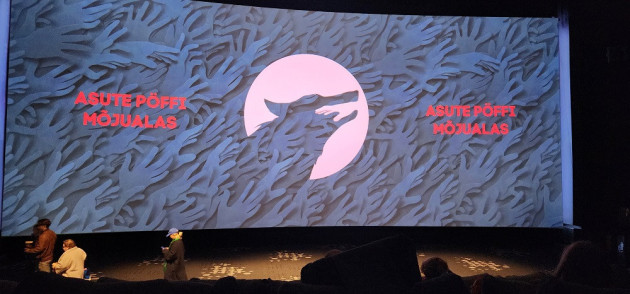
PӦFF stage (photo source, Joshua Polanski)
A seemingly minor film of the movement, Crows (1969) comes two years before WR: Mysteries of the Organism, arguably the crowning achievement of Yugoslav cinema, and near the end of the movement. Co-directors Ljubiša Kozomora and Gordan Mihić depict a world crumbling beneath the feet of Djuka (Slobodan 'Cica' Perović), an amateur boxer with no money and lots of responsibilities. He tends to his elderly mother (Jovanka Kotlajić), who cares not for social conventions and dreams of traveling to Russia, and gets involved with a medley group of ballerina dancers that need a ride to Belgrade—a somewhat rebellious premise in and of itself. He and his new friends find themselves willing to do almost anything to ameliorate their bleak financial situations, including murder.
In many ways, I was reminded of Rainer Werner Fassbinder’s debut Love Is Colder Than Death (ironically, from the same year). Both films come from similar post-war film movements that stretched thematic and formal freedom in their respective national cinemas. And like Fassbinder’s film, Crows glimpses non-neutrally into the criminal underbelly of urban society: thuggery, theft, murder. The main characters even don a similar stylish hat. Kozomora and Mihić’s film, unlike Fassbinder’s, reserves the stylistic flourishes for the biggest moments. Only on a few occasions do the directors ever depart from their naturally lit and close-up intensive cinematographic style; when they do depart, with snappy zooms and prolonged long shots of violence, they conduct the eyes of viewers with tremendous care. The great German director, by contrast, especially in his debut, was never known for his reserved style.
I’m most puzzled by one scene where the three dancers (two women and one stereotypically flamboyant man) and Djuka attempt to rob a man while he sleeps with one of the women. The man shows no interest in the woman chosen and sheepishly signals that he wants the ballerina man. The friends quickly murder him for his homosexuality (and money) and run away after a listless cover-up.
The easy read of the scene is classic homophobia. But this might be too easy. While sympathizing with the plight of the poor main characters, the screenplay never truly valorizes as much as pities them. The violence is arguably the turning point in the final act, the moment that finally breaks Djuka (as the zoom in the finale attests). Given this emotional breakage, one would be forgiven for reading the homosexual-murder as irreverent toward Yugoslav communism.
Then again, it was 1969, and homosexuality wasn’t decriminalized in the country until 1977. Maybe the easy read is the correct one.
Five and a Half Love Stories in an Apartment in Vilnius, Lithuania
My last film of the festival was one of the best I saw, Tomas Vengris’s one-location vignette anthology with a really long title, Five and a Half Love Stories in an Apartment in Vilnius, Lithuania. Co-written with Tatia Rosenthal, Vengris’s film won the Rebels with a Cause Competition, his second major award from PӦFF over the years; his debut, Motherland, won the Best Film in the Baltic Competition in 2019. And while I wasn’t able to catch every title in this year’s Rebel program, Five and a Half Love Stories is certainly a deserving winner.
All five stories take place within one Airbnb in the Lithuanian capital and function as largely independent short stories with a few linking elements. Most essentially, Jolanta (Velta Žygure) cleans the apartment between each visit and develops a budding courtship of her own with a man next door. At the beginning of each chapter (each named after a Shakespeare sonnet) cinematographer Jurgis Kmins makes the building quake as if it has an earthquake problem, disrupting the would-have-been nothingness of the empty apartment. The apartment appears to be falling down and this bookends each vignette—a telling glimpse into the nature of these love stories. As far as the inter-connections go, a secondary character from the second story, an abusive lover-neighbor, stops by to visit a friend in the third (only because he thought there was a chance it was his ex-girlfriend), and a ring lost in one pops up in another. In the most rewarding connection, a male stripper from the first story, Mykolas (Marijus Mažūnas), returns for the fourth. Beyond these easter-egg plot devices, each of the five chapters—other than the fifth, in which Jolanta plays a key role—would, on a narrative level, satisfy effectively the same if presented as a short.
Five and a Half Love Stories in an Apartment in Vilnius, Lithuania, of course, is a double-entendre. The more obvious meaning comes from the five chapters and the interlude between (although the interludes become the final chapter so the counting would be off here) and the less obvious meaning of the title being a reference to apartment marketing language. The playful title also prepares the way for a playful mood that the screenplay deconstructs with great integrity. The funniest moment, in the fourth story, involves unexpected homosexual nudity in front of an old Polish couple and doubles as one of the film’s most heartbreaking scenes, for example. The tonal shift from amusement to comedic to tragic repeats with each chapter. These “love stories” are messy and even contradictory. Incessant bickering, infidelity, homophobia, and denied intimacy are not exactly the themes that make for easy-going date-night movie romance. That’s not to say the “love stories” in the title misleads; I don’t think that’s true, actually. Vengris and co-writer Rosenthal are just brutally honest in their acknowledgment that love is a complicated, painful, and messy affair.
Despite spending 112 minutes within the apartment, the interior doesn’t really project a super-clear geography. I may be recalling wrong, but … I don’t believe the cameras move in the slightest. They record and capture but they are strictly observational, even if they hold fantastic potential; moving cameras, in tight interior spaces, often make up for the impossibility of a well-encompassing establishing shot. I don’t think of this as a problem, but I just find it kind of remarkable that it’s possible to spend so much time within one space and yet even a careful viewer may leave never truly feeling like one knows the place.
There’s also something almost fantastical. The empty still shots of the apartment rumbling and nearing collapse foretell impending doom by adapting Shakespearean tendencies to the present. The camera never leaves the apartment even when the guests do. In these cases, Kmins aims his aperture outside the window and keeps a distance while doing so. Somehow the camera never feels tempted to leave, imbuing the apartment with a sense of perspective itself through its loyalty to the interior point-of-view. The few conversations outside go unheard and interactions distanced. The Airbnb is a space with a life of its own, as far as the camera cares, and that makes it routinely fantastic. Of course, if it’s fantasy, it must be of the darker sort and the collapsing apartment makes us remember this. The lofty chapter titles like “Love Alters Not, Sonnet 116” practically soothsay the unhappy endings.
The sales rights to Five and a Half Love Stories in an Apartment in Vilnius, Lithuania were just purchased by UK-France sales agent Alief during the festival, and hopefully, this signals a long life for the Lithuanian award-winning film. I know I would love to catch it again.




